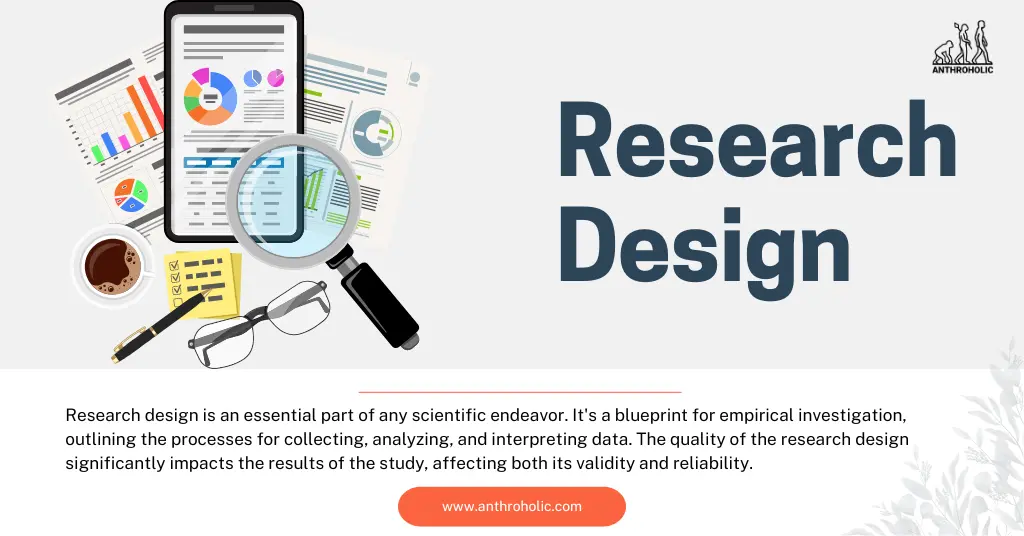AI Answer Evaluation Platform Live Now. Try Free Answer Evaluation Now
Research Design
Research design is an essential part of any scientific endeavor. It’s a blueprint for empirical investigation, outlining the processes for collecting, analyzing, and interpreting data [1]. The quality of the research design significantly impacts the results of the study, affecting both its validity and reliability.

Types of Research Design
Research designs can be broadly classified into three categories:
- Descriptive Design: This design seeks to describe a phenomenon or situation as it is without attempting to change or manipulate variables. This includes observational studies, surveys, and case studies [2].
- Experimental Design: Here, the researcher manipulates one or more variables and observes the effect on another variable. It includes true experimental design, quasi-experimental design, and pre-experimental design [3].
- Correlational Design: This design aims to examine the relationship between two or more variables without manipulation. It includes cross-sectional, longitudinal, and sequential designs [4].
Components of Research Design
The four key components of a research design include:
- Purpose of the Study: This outlines why the research is being conducted. It may include exploration, description, or explanation [5].
- Type of Investigation: This defines whether the study is correlational or causal.
- Researcher Control: This indicates the extent to which the researcher manipulates variables.
- Time Dimension: This indicates whether the research is cross-sectional (at a particular time) or longitudinal (over a period of time) [6].
Table 1: Components of Research Design
| Component | Description |
|---|---|
| Purpose of the Study | Defines why the research is being conducted |
| Type of Investigation | Determines if the study is correlational or causal |
| Researcher Control | Shows the level of manipulation by the researcher |
| Time Dimension | Indicates if the study is cross-sectional or longitudinal |
Choosing the Right Research Design
Selecting the correct research design is crucial for the success of any research study. Here are few tips to make the right choice:
- Understand the research question and goals. Your design should align with your objectives.
- Evaluate the resources available, including time, funding, and technical expertise.
- Consider ethical implications. Make sure your research design meets the ethical standards in your field [7].
Strengths and Weaknesses of Research Designs
Each research design has its strengths and weaknesses:
Descriptive Design
- Strengths: Good for generating new ideas and identifying variables.
- Weaknesses: Cannot determine causal relationships [8].
Experimental Design
- Strengths: Best for determining cause-and-effect relationships.
- Weaknesses: May not fully represent real-world conditions [9].
Correlational Design
- Strengths: Good for studying large groups and complex variables.
- Weaknesses: Cannot prove that one variable causes changes in another [10].
Mixed-Methods Research Design
An increasingly popular approach to research design is the mixed-methods design. This involves integrating both qualitative (focused on understanding and interpretation) and quantitative (centered on testing and measurement) research [11].
The advantages of mixed-methods designs include:
- Complementarity: Using different methods can provide a more comprehensive understanding of the phenomena being studied.
- Triangulation: Comparing results from different methods can increase the validity of the findings.
- Expansion: Different methods can provide more depth and breadth to a study [12].
However, there are also challenges associated with mixed-methods designs, such as additional resources required and the need for expertise in both qualitative and quantitative methods [13].
Ethical Considerations in Research Design
Regardless of the chosen research design, it’s vital that all researchers adhere to ethical standards. Some key ethical considerations include:
- Informed Consent: Participants should understand what they’re agreeing to when they participate in a study [14].
- Confidentiality: Researchers should protect the identities of participants.
- Honesty and Integrity: Researchers should present their findings honestly and avoid falsifying or misrepresenting data [15].
- Avoidance of Harm: Researchers should not harm the participants physically, emotionally, or psychologically.
The Future of Research Design
The future of research design is dynamic and evolving. With advancements in technology, researchers have more tools at their disposal. This will potentially lead to new types of research design, particularly in fields like data science, bioinformatics, and other interdisciplinary areas.
Emerging trends include the use of big data, artificial intelligence, and virtual reality in research designs. For example, the use of AI in experimental designs to identify optimal experimental conditions [16].
Conclusion
A well-designed research study provides a robust foundation for data collection and analysis, helping researchers draw meaningful conclusions. By understanding the different types of research designs and their components, researchers can make informed choices about their studies. In choosing a research design, it’s essential to keep in mind the study’s goals, resources available, and ethical considerations.
References
[1] Creswell, J. W., & Creswell, J. D. (2017). Research design: Qualitative, quantitative, and mixed methods approaches. Sage publications.
[2] Robson, C., & McCartan, K. (2016). Real world research. Wiley.
[3] Campbell, D. T., & Stanley, J. C. (2015). Experimental and quasi-experimental designs for research. Ravenio Books.
[4] Shadish, W. R., Cook, T. D., & Campbell, D. T. (2002). Experimental and quasi-experimental designs for generalized causal inference. Houghton, Mifflin and Company.
[5] Babbie, E. (2015). The Practice of Social Research. Cengage Learning.
[6] Neuman, W. L. (2013). Social research methods: Qualitative and quantitative approaches. Pearson Education.
[7] Israel, M., & Hay, I. (2018). Research ethics for social scientists. Sage.
[8] Neuman, W. L. (2013). Social research methods: Qualitative and quantitative approaches. Pearson Education.
[9] Shadish, W. R., Cook, T. D., & Campbell, D. T. (2002). Experimental and quasi-experimental designs for generalized causal inference. Houghton, Mifflin and Company.
[10] Field, A. (2013). Discovering statistics using IBM SPSS statistics. Sage.
[11] Creswell, J. W., & Clark, V. L. P. (2017). Designing and conducting mixed methods research. Sage publications.
[12] Johnson, R. B., Onwuegbuzie, A. J., & Turner, L. A. (2007). Toward a definition of mixed methods research. Journal of mixed methods research, 1(2), 112-133.
[13] Tashakkori, A., & Teddlie, C. (2010). SAGE handbook of mixed methods in social & behavioral research. Sage.
[14] Beauchamp, T. L., & Childress, J. F. (2013). Principles of biomedical ethics. Oxford University Press.
[15] Israel, M., & Hay, I. (2018). Research ethics for social scientists. Sage.
[16] M. Zaharia, M. Chowdhury, T. Das, A. Dave, J. Ma, M. McCauley, M. J. Franklin, S. Shenker, I. Stoica. (2016). Resilient distributed datasets: A fault-tolerant abstraction for in-memory cluster computing. In Proceedings of the 9th USENIX conference on Networked Systems Design and Implementation (NSDI’12). USENIX Association.




